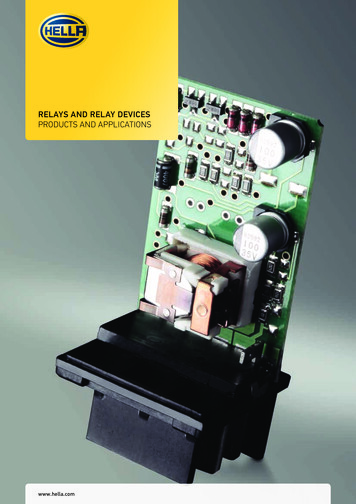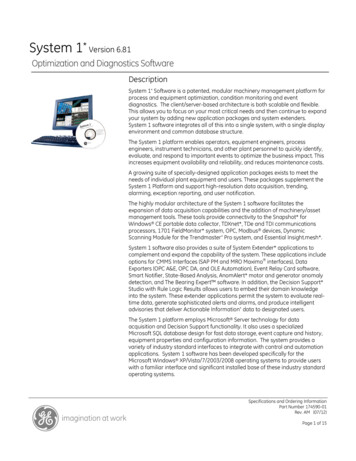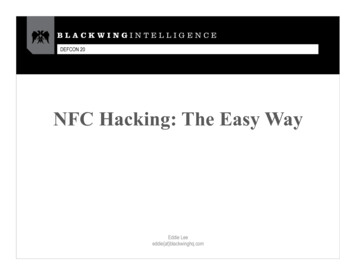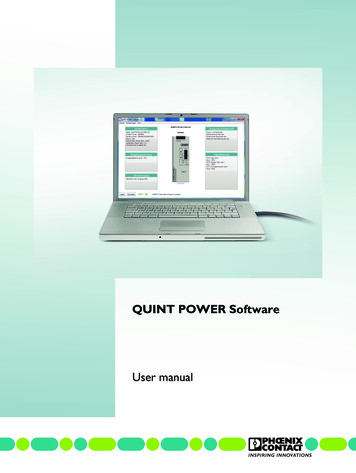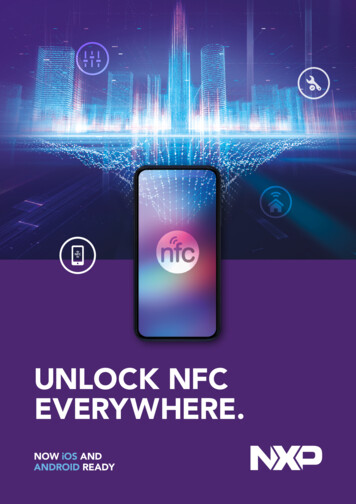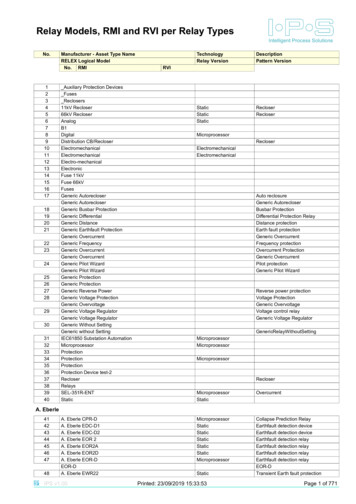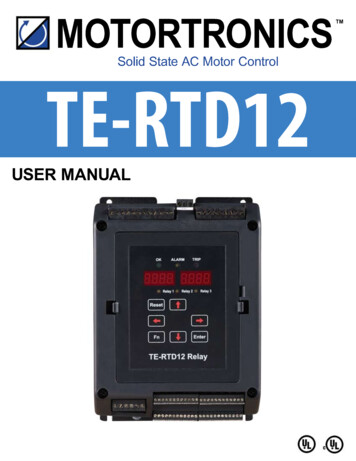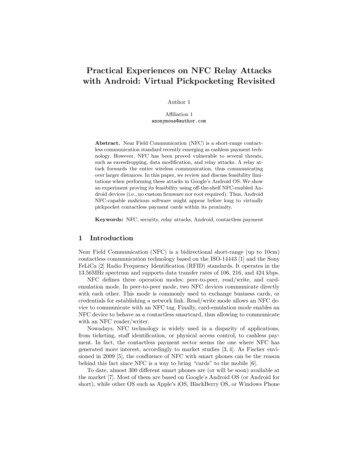
Transcription
Practical Experiences on NFC Relay Attackswith Android: Virtual Pickpocketing RevisitedAuthor 1Affiliation 1anonymous@author.comAbstract. Near Field Communication (NFC) is a short-range contactless communication standard recently emerging as cashless payment technology. However, NFC has been proved vulnerable to several threats,such as eavesdropping, data modification, and relay attacks. A relay attack forwards the entire wireless communication, thus communicatingover larger distances. In this paper, we review and discuss feasibility limitations when performing these attacks in Google’s Android OS. We showan experiment proving its feasibility using off-the-shelf NFC-enabled Android devices (i.e., no custom firmware nor root required). Thus, AndroidNFC-capable malicious software might appear before long to virtuallypickpocket contactless payment cards within its proximity.Keywords: NFC, security, relay attacks, Android, contactless payment1IntroductionNear Field Communication (NFC) is a bidirectional short-range (up to 10cm)contactless communication technology based on the ISO-14443 [1] and the SonyFeLiCa [2] Radio Frequency Identification (RFID) standards. It operates in the13.56MHz spectrum and supports data transfer rates of 106, 216, and 424 kbps.NFC defines three operation modes: peer-to-peer, read/write, and cardemulation mode. In peer-to-peer mode, two NFC devices communicate directlywith each other. This mode is commonly used to exchange business cards, orcredentials for establishing a network link. Read/write mode allows an NFC device to communicate with an NFC tag. Finally, card-emulation mode enables anNFC device to behave as a contactless smartcard, thus allowing to communicatewith an NFC reader/writer.Nowadays, NFC technology is widely used in a disparity of applications,from ticketing, staff identification, or physical access control, to cashless payment. In fact, the contactless payment sector seems the one where NFC hasgenerated more interest, accordingly to market studies [3, 4]. As Fischer envisioned in 2009 [5], the confluence of NFC with smart phones can be the reasonbehind this fact since NFC is a way to bring “cards” to the mobile [6].To date, almost 300 different smart phones are (or will be soon) available atthe market [7]. Most of them are based on Google’s Android OS (or Android forshort), while other OS such as Apple’s iOS, BlackBerry OS, or Windows Phone
OS are less representative. For instance, Apple has just started to add NFCcapabilities into its devices: Apple’s iPhone 6 is the first model integrated withan NFC chip, although is locked to work only with Apple’s contactless paymentsystem [8]. As a recent market research states [9], this trend will keep growingup, expecting to reach more than 500 million of NFC payment users by 2019.Unfortunately, NFC is insecure as claimed by several works [10–13], whereNFC security threats and solutions have been stated. Potential threats of NFCare eavesdropping, data modification (i.e., alteration, insertion, or destruction),and relay attacks. Eavesdropping can be avoided by secure communication, whiledata modification may require advanced skills and enough knowledge about RFtransmission, as well as ad-hoc hardware to perform the attack. A relay attack,defined as a forwarding of the entire wireless communication, allows to communicate over a large distance. A passive relay attack forwards the data unaltered,unlike an active relay attack [14]. In this paper, we focus on passive relay attacks.Relay attacks were though to be really difficult or almost impossible toachieve, since the physical constraints on the communication channel. However,the irruption of NFC-enabled mobile phones (or devices) completely changes thethreat landscape: Most NFC communication can be relayed – even NFC payment transactions – with NFC-enabled devices. Many works have proved thisfact under different attack scenarios, as we reviewed in Section 5.Mobile malicious software (i.e., malware) usually target user data (suchas user credentials or mobile device information), or perform fraud throughpremium-rate calls or SMS, but we believe that the rise of NFC-enabled devices put NFC in the spotlight for malware developers [15]. To the best of ourknowledge, to date there not exist any malware with NFC capabilities althoughthey might appear before long. To prove whether an NFC-capable malware mightexist nowadays, in this paper we study the feasibility of passive relay attacks inAndroid. Android is used since it leads the global smartphone market [16] andprovides a broad set of freely resources for the developers.The contribution of this paper is twofold: First, we discuss the implementation alternatives to perform NFC relay attacks in Android; Second, we show apractical implementation of these attacks using two NFC-enabled mobile phonesrunning an off-the-shelf (OTS) Android (i.e., no custom firmware nor root permissions). Our findings put in evidence that these scenarios are nowadays feasible, requiring permission only of NFC and relay communication link chosen(e.g., Bluetooth, WiFi, or GPRS). This issue clearly supposes a high securityrisk: An NFC-capable malware installed on an Android device can interact withany contactless payment cards in its proximity, being able to conduct illegaltransactions. Current limitations and feasibility of some malware attack scenarios are also introduced.The outline of this paper is as follows. Section 2 introduces previous concepts.In Section 3, we analyse and discuss practical issues of alternatives provided byAndroid to perform an NFC passive relay attack. Section 4 describes a practical implementation of this attack using OTS Android NFC-enabled devices,
discusses threat scenarios, and introduces countermeasures. Section 5 reviewsrelated works. Finally, Section 6 states conclusions and future work.2BackgroundThis section first briefly introduces the ISO/IEC 14443 standard [17] since contactless payment cards rely on it. Then, relay attacks and mafia frauds areintroduced. Finally, we review the history of NFC support in Android.2.1ISO/IEC 14443 StandardISO/IEC 14443 is a four-part international standard for contactless smartcardsoperating at 13.56 MHz [17]. Proximity Integrated Circuit Cards (PICC), alsoreferred to as tags, are intended to operate up to 10cm of a reader antenna,usually termed as Proximity Coupling Device (PCD).Part 1 of the standard defines the size, physical characteristics, and environmental working conditions of the card. Part 2 defines the RF power and twosignalling schemes, Type A and Type B. Both schemes are half duplex witha data rate of 106kbps (in each direction). Part 3 describes initialisation andanticollision protocols, as well as commands, responses, data frame, and timing issues. A polling command is required for waking both card types up andstart communication. Part 4 defines the high-level data transmission protocols.A PICC fulfilling all parts of ISO/IEC 14443 is named IsoDep card (for instance,contactless payment cards). As response to the polling phase, a PICC reportswhether Part 4 is supported. Apart from specific protocol commands, the protocol defined in Part 4 is also capable of transferring Application Protocol DataUnits (APDUs) as defined in ISO/IEC 7816-4 [18] and of application selectionas defined in ISO/IEC 7816-5 [19]. ISO/IEC 7816-4 and ISO/IEC 7816-5 arepart of ISO/IEC 7816, a fifteen-part international standard related to contactedintegrated circuit cards, especially smartcards.2.2Relay Attacks and Mafia FraudsRelay attacks were initially introduced by John Conway in 1976 [20], where heexplained how a player without knowledge of the chess rules could win to aGrandmaster. To relate these attacks in detail, let us recall here to the wellknown people in the security community Alice, Bob, and Eve.Consider Grandmasters Alice, Bob, who are both challenged by Eve at thesame time to play a correspondence chess game (i.e., chess movements are received and sent via email, postal system, or others long-distance correspondencemethods). Eve, who ignores the rules, selects a different colour pieces in eachmatch. When playing, she only needs to relay movements received/sent from onematch to the other, until a match ends. Fig. 1 shows the scenario described byConway. Note that both Alice, Bob, think they are playing against Eve, but infact they are playing between them.
To the best of our knowledge, the first workintroducing relay attacks in systems where security is based on the proximity concern is [21].Desmedt defined the mafia fraud as a relay attack where a dishonest prover P ′ and a dishonest verifier V ′ act together to cheat to a honestverifier V and a honest prover P , respectively,as: V P ′ communication link V ′ P, where P ′ , V ′ , communicates oneeach other through a communication link.Herein, we adhere to this terminology to refer to the contactless payment card (honestprover), the legitimate Point-of-Sale (PoS) terminal (honest verifier), and the two NFCenabled Android devices used to perform an Fig. 1. Chess game relay scenario.NFC passive relay attack (dishonest proverand dishonest verifier).2.3Evolution of NFC Support in Google’s Android OSNFC support in Android began with Android version 2.3 (Gingerbread codename), where only peer-to-peer (used by Android Beam) and read/write operation modes were natively supported. This initial limitation was overcome by thefollowing version updates, being incrementally completed up to gaining an NFCfull support and a really comprehensive API for developers in Android version4.4 (KitKat codename). In read/write operation mode, different communicationprotocols and tags are supported, depending on the NFC chip manufacturer(e.g., ISO/IEC 14443-3 Type A, Type B, and IsoDep tags, to name a few).Card emulation is the mode with more substantial changes among versions. Inthe early NFC-enabled Android versions, this mode was only provided via hardware using Secure Elements (SEs) following GlobalPlatform specifications [22].A SE provides a tamper-proof platform to securely store data and execute applications, thus maintaining confidential data away from an untrusted host. WithSE card emulation, the NFC controller directly routes all communication fromexternal reader (e.g., a PoS terminal) to the tamper-resistant chip, without passing through the OS. That is, NFC communication remains transparent to theOS. SEs are capable to communicate not only with the NFC controller but alsowith mobile applications running within the OS (such as electronic wallets) andover-the-air with the Trusted Service Manager (TSM).TSM is an intermediary authority acting between mobile network operatorsand phone manufacturers (or other entities controlling a SE) and enabling theservice providers (such as banks) to distribute and manage their applicationsremotely. This closed, distributed ecosystem guarantees a high level of confidenceand has been mainly used by the payment sector. However, it excludes otherdevelopers from using the card emulation mode. As a result, many developersasked for an easier access to this resource.
The first solution was provided by BlackBerry Limited (formerly known asResearch In Motion Limited) company, which included software card emulation(or “soft-SE”) mode in BlackBerry 7 OS [23]. This mode allowed the interactionof RFID readers and mobile phone’s applications directly, thus completely opening the card emulation to any developer. Basically, soft-SE (also named as HostCard Emulation, HCE) allowed the OS to receive commands from the NFC controller and to response them by any applications instead of by applets installedon a SE.HCE feature was unofficially supported to Android in 2011, when Doug Yearreleased a set of patches for Android CyanogenMod OS (version 9.1 onward).These patches provided an HCE mode and a middleware interface adding twonew tag technologies (namely, IsoPcdA and IsoPcdB). However, this implementation worked only for a specific NFC controller (particularly, NXP PN544), included at those dates in Google’s Android devices such as the Samsung GalaxyNexus or Asus Nexus 7 (first generation). Finally, Android officially supportsHCE mode since October 2013, when Android KitKat was released.3Practical Implementation Alternatives in AndroidThis section first introduces the Android NFC architecture. Then, we focus onimplementation issues of read/write and card-emulation operation modes in Android as these modes allow to act as a dishonest verifier and a dishonest prover,respectively, in an NFC attack relay. Finally, we point three limitations out whenperforming these attacks in Android, and discuss its feasibility.3.1Android NFC Architecture: NCI StackAndroid NFC development offers an event-driven framework and extensive APIon two native implementations that depends on the NFC chip within the device:– libnfc-nxp, which provides support for NXP PN54x NFC controllers andNXP MIFARE family products. These products are not supported by allNFC-enabled devices, since they use a proprietary transmission protocol(that is, MIFARE family cards are not IsoDep cards).– libnfc-nci, which provides support for any NFC Controller Interface(NCI) [24] compliant chips, such as Broadcom’s BCM2079x family.Nowadays, NCI leads the NFC development by several reasons: (i) it provides an open architecture not focused on a single family chip; (ii) it offers anopen interface between the NFC Controller and the DH; and (iii) it is a standard proposed by NFC Forum, a non-profit industry association that developsNFC specifications, ensures interoperability, and educates the market about NFCtechnology. In this paper, we focus on NCI by the same reasons.NCI specification aims at making the chip integration of different manufacturers easier by defining a common level of functionality among the components
Fig. 2. NFC architecture (taken from [24]).of an NFC-enabled device. It also provides a logical interface that can be usedover different physical channels, such as UART, SPI, and I2C.A noteworthy fact is that Google dropped NXP in favour of Broadcom’s NFCstack in their latest Nexus devices (from LG Nexus 4 onward). Moreover, theAndroid Open Source Project does not support HCE mode for old NXP PN544chipsets since they lack of AID dynamic routing capabilities, being only possibleto use it in devices with closed-source factory ROMs (e.g., Sony Xperia Z1, SonyCompact Z1, and Sony Z Ultra). Latest NFC chipsets developed by NXP, suchas NXP PN547, support HCE mode since they are NCI-compliant.Three main actors are distinguished in a NCI-compliant NFC scenario, asdepicted in Fig. 2: the NFC Execution Environment (NFCEE), which is a hardware module in most cases (e.g., embedded SEs or Single Wire Protocol enabledSD-Cards); the NFC Controller (NFCC); and the Device Host (DH), which refersto the main processor, i.e., the own NFC-enabled device.The NFCC transmits and receives information over the RF channel and ispart of a system-on-chip. It maintains a connection with the DH and othersNFCEE using the NCI, which defines a logic interface between them independently of the physical layer. NCI also deals with data packet fragmentation,according to the MTU defined by the physical layer.NCI defines two message types, packed and transmitted over a particularphysical channel: (1) Control messages, subdivided in commands, responses,and notifications. Commands are only sent from the DH to the NFCC, whereasthe others travel in both directions; and (2) Data messages, which carry theinformation addressed to the NFC endpoint (i.e., a remote tag or reader). Thesemessages are only sent once the logic channel has been established. During initialisation, the default communication channel is set to the RF connection, althoughmore channels can be created with others NFCEEs.NCI modules, such as the RF Interface modules, are a key part of the NCIstack. An RF Interface module defines how the DH communicates with a givenNFC endpoint through the NCI. Each RF Interface supports a specific RF protocol and determines how the NCI data-message payload fits on its respective
RF message. This layered design allows a modular addition of interfaces implementing new protocols.3.2Read/Write Operation ModeAndroid applications are not allowed to directly set the device into read/writemode. However, this mode is indirectly reached as follows: First, it registers theset of NFC tags of interest to be detected through the AndroidManifest.xmlfile; and then, the Android NFC service selects and starts the registered application whether a tag of interest is discovered (i.e., it enters in its proximitycommunication range). Applications can also ask preference for a discovered tagwhen they are in foreground mode.The tag can be discovered by means of the NFCC, which polls the magneticfield. Once a tag is detected, the NFCC first determines the protocol and thetechnology used. Then, it sends an NCI notification message to the DH with thetag details. The DH (indeed, the NfcService in Android) handles this notification and fills a Tag object with the data received from the NFCC. Finally, theDH creates and emits an Intent with the EXTRA TAG field, which is received bythe registered Android application with higher preference.Android NFC API offers an specific class per RF protocol (i.e., to workwith different type of NFC tags) built on top of TagTechnology interface.These classes implement the high-level I/O blocking transceive(byte[] data,boolean raw) method, which is used to communicate a DH with an NFC tag.Such a method can work with old NFC implementations (raw boolean flag)where some preprocessing is needed before transmitting through the RF channel(e.g., to compute and add CRC payloads to messages). Current libnfc-nciimplementation ignores this flag, while libnfc-nxp implementation uses it todistinguish between ISO/IEC 14443 or NXP proprietary commands. In fact,the transceive method executes via Inter Process Communication (IPC) aremote invocation on TagService object, defined in NfcService. This objectis also associated to a TagEndpoint object, which references to the remote tagand whose implementation relies on the native library used (libnfc-nci orlibnfc-nxp). Thus, the Android NFC API offers an abstraction of its internalimplementation.Lastly, let us briefly describe low-level issues. The libnfc-nci implementation uses a reliable mechanism of queues and message passing named GeneralKernel Interface (GKI) to easily communicate between layers and modules: Eachtask is isolated, owning a buffer (or inbox) where messages are queued and processed on arrival. This mechanism is used to send messages from the DH to theNFCC chip, and vice versa.3.3Host-Card Emulation Operation ModeAndroid applications can directly use HCE operation mode by implementinga service to process commands and replies, unlike read/write operation mode,restricted to Android activities. The aforementioned service must extend the
HostApduService abstract class and implement the processCommandApdu andonDeactivated methods.The processCommandApdu method is executed whenever an NFC readersends an APDU message to the registered service. Recall that APDUs arethe application-level messages exchanged in an NFC communication betweena reader/writer and an IsoDep tag, defined by the ISO/IEC 7816-4 specification(see Section 2.1). In fact, an IsoDep-compliant reader initiates the NFC communication by sending an explicit SELECT APDU command to the smartcard tochoose a specific Application ID (AID) to communicate with. This command isfinally routed by the NFCC to the registered application for the specified AID.Therefore, each application must previously register the AID list of interest,in order to receive APDU commands. As in the previous case, registration isperformed by means of AndroidManifest.xml file. Fortunately, Android version5.0 (Lollipop codename) onward enables to dynamically register AIDs.The Android NFC service (i.e., NfcService) populates during initialisationan AID routing table based on the registered AIDs of each application. Thistable is basically a tree map of AIDs and services.When the DH receives a SELECT command, the routing table is checkedand the corresponding service is set to defaultService. Thereafter, subsequentAPDU commands are routed to that service until other SELECT command is received, or a deactivation occurs (by a DESELECT command or a timeout). Routingprocess is performed by Messenger objects sent between the NfcService andthe HostApduService: When the NfcService needs to route a message, it sendsa MSG COMMAND APDU to HostApduService, which extracts the APDU payloadand executes processCommandApdu. Similarly, an analogous process occurs witha response, but handling a MSG RESPONSE APDU instead.Lastly, remark that the NFCC also maintains a routing table populated during each NfcService activation. In this case, it stores the destination routeaccording to a set of rules: Technology, Protocol, or specific AID. Destinationroute can be either the DH (default option) or other NFCEE, such as a SE.3.4Limitations and DiscussionAs previously described, Android NFC architecture is composed by differentlayers acting at different levels. Table 1 summarises these layers in top-downdeveloper-accessible order, giving also details of implementation languages, onwhom depend them, and whether the code is open source software (OSS).We envisioned three major limitations when performing an NFC relay attackwith dishonest parties (i.e., prover and verifier) in Android.Limitation 1. The scenario envisioned by this limitation depicts an NFC-enableddevice with a non-NXP NFCC (the device, for short) acting as a dishonestverifier and communicating with a legitimate proprietary tag such as MIFAREClassic smartcards. The device must be in read/write mode. Since libnfc-nciimplementation does not allow sending raw ISO/IEC 14443-3 commands, thedevice is unable to communicate with these proprietary tags. Note that the
DescriptionNFC developer framework(com.android.nfc package)System NFC library(libnfc-nxp or libnc-nci)NFC Android kernel driverLanguage(s)Java, C DependencyAPI levelOSSYesC/C ManufacturerYesCHardwareand YesmanufacturerNFC firmware(unknown)Hardware andNo(/system/vendor/firmware directory)manufacturerTable 1. NFC architecture levels in Google’s Android OS.standard defines a CRC field for each command before sent. We have empiricallyverified where Android computes this CRC value. After some debugging and codereview, we concluded that the entity responsible of this computations is, in fact,the ISO/IEC 14443-3 RF Interface module of the NFCC.Therefore, this limitation is very unlikely to be circumvented, unless NFCCis modified. On the contrary, since contactless payment cards are IsoDep cards(i.e., fully ISO/IEC 14443-compliant), this issue does not really occur at all.Limitation 2. In this case, we considered an NFC-enabled device acting as adishonest prover that communicates with a honest verifier. The device must bein HCE mode, which is natively supported from Android KitKat onward (seeSection 2.3). Besides, the specific emulated AID has to be known in advance (seeSection 3.3). However, since the routing process is performed in the first layer,it could be surrounded in a device with root permissions. Indeed, there existsan Xposed framework module that addresses this issue. The Xposed frameworkprovides a way to make system-level changes into Android without installing acustom firmware, but needs root permissions instead.Therefore, an OTS Android (version 4.4) onward, dishonest prover can communicate with a honest verifier emulating any AID when this value is known inadvance. Otherwise, an Android device with root permissions is needed.Limitation 3. Finally, we envisioned a complete NFC passive relay attack scenario where a dishonest prover and a dishonest verifier communicate through anon-reliable peer-to-peer relay channel. Note that the success of the relay attackrelies on the delay introduced by this communication link. A good review onNFC relay timing constraints can be found in [25]. ISO/IEC 14443-3 [17] specifies a timings values that were found too low for software emulation on mobiledevices [26]. However, ISO/IEC 14443-4 [27] defines the Frame Waiting Timeas F W T 256 · (16/fc) · 2F W I , 0 F W I 14, where fc 13.56MHz (i.e.,the carrier frequency). Thus, F W T ranges from 500µs to 5s, which practicallysolves most timing problems in any relay channel. Moreover, the standard alsoallows to request additional computation time by the PICC with a WTX message,which might potentially be implemented on Android to give an attacker addi-
tional time for a relay. We aim at further studying the feasibility of these attacksin Android that we named as timed-extension NFC relay attack.Therefore, an NFC relay attack on ISO/IEC 14443-4 is feasible whether thedelay on the relay channel is less than 5 seconds. Recall that ISO/IEC 14443-4is the protocol used by the contactless payment cards.Let us remark that F W I is completely generated by the NFCC and notconfigurable by the Android NFC service on HCE mode. Although official documentation defines a F W I 8 (i.e., F W T 78ms), some PoS devices ignoreF W T command sent by the PICC to provide better user responses (and thus,a longer time window). From a read/write mode point of view, this constraintdoes not happen since Android allows to set a timeout up to 5s.Conclusions. To summarise, any NFC-enabled device running OTS Androidversion 4.4 onward is able to perform an NFC passive relay attack at APDUlevel when the specific AID of the honest prover is known.4Relay Attack ImplementationIn this section, we first perform a proof-of-concept experiment of relay attackat contactless payment cards. Then, we foresee threat scenarios of NFC-capableAndroid malware that may appear before long. Finally, countermeasures arebriefly discussed.4.1Proof-of-Concept ExperimentRecall that three parts are involved in an NFC relay attack (see Section 2.2):(i) a peer-to-peer relay communication channel; (ii) a dishonest verifier, whichcommunicates with the honest prover (i.e., a contactless payment card in thiscase); and (iii) a dishonest prover, which communicates with the honest verifier(i.e., a PoS in this case). The dishonest verifier works in read/write operationmode, while the dishonest prover relies on HCE operation mode.For ethical reasons we used our own PoS device. Namely, an Ingenico IWL280with GPRS and NFC support. As dishonest prover and verifier, we used two offthe-self Android NFC-enabled mobile devices executing an Android applicationdeveloped for testing purposes (about 2000 Java LOC and able to act as dishonest verifier/prover, depending on user’s choice), having a single constraint: Thedishonest prover must execute, at least, an Android KitKat version (first versionnatively supporting HCE mode, see Section 2.3). The experiment has been successful tested on several mobile devices, such as Nexus 4, Nexus 5 as dishonestprovers, and Samsung Galaxy Nexus, Sony Xperia S as dishonest verifiers.The experiment execution workflow is as follows: First, each dishonest partychooses its role (prover or verifier); Then, a peer-to-peer relay channel is established. Finally, the dishonest verifier connects with a contactless payment card,and the dishonest prover relays every APDU from the PoS to the card, and viceversa. Thus, a successful payment transaction is conducted.
V P 00A4 0400P V 6F2D 840E0000 0003V P 00A4 0400P V 6F33 8407189F 6604(messages omittedV P 80AE 80002400 37FBP V 7729 9F27XXXX XXXX0E32 50413250 41591010 500B07A0 0000A000 00009F02 069Ffor privacy2B00 000088BD 220001XX 9F36XXXX XXXX592E 53592E53 59535649 53410003 10100310 10A50306 9F1Aissues)0000 01000000 000002XX XX9FXXXX XXXX532E2E44204200285002954444 4630 31004446 3031 A51B BF0C 1861 164F 07A0414E 4B49 4190 00000000002608XXXX00000000XXXXXX900B56 4953 4120 4241 4E4B 4941 9F38055F 2A02 9A03 9C01 9F37 0490 000007 2480 0000 8000 0978 1502001F 0302 00XXXX XXXX XXXX 9F10 12XX XXXX00Table 2. Trace excerpt of a MasterCard contactless payment relayed.Table 2 shows a time-ordered trace excerpt of a MasterCard contactless transaction, indicating the message flow. First, SELECT command (00A4) is sent toask the payment applications within the card. Then, MasterCard application isselected. We omit messages that contain sensitive parameters. Similarly, we obfuscate some bytes relative to cryptogram application generation (last messageshown). A video demo of the experiment is publicly available at URL HIDDENTO REMAIN ANONYMOUS.4.2Threat ScenariosFig. 3 depicts a pair of threat scenarios using this attack vector. In Fig. 3(a),we envisioned a network of Android infected devices (i.e., a botnet) that communicate with the bot master when a contactless payment card is detected. Thebot master can use this smartcard to conduct illegal transactions with a honest verifier, or even multiple transactions at the same time collaborating withmultiple dishonest verifiers. We named this attack as distributed mafia fraud.Fig. 3(b) foresees the same scenario than before, but with multiple dishonestprovers committing fraud at the same time, as a way to hide their real location.Note that contactless payment cards implement security mechanisms suchas asking for a PIN after several uses and checking of atypical paying locations.These mechanisms clearly minimise the impact of the second threat scenarioenvisioned.Lastly, let us remark a limitation of these attacks performed as an Androidmalware. Since read/write operation mode in Android is only reachable by activities (see Section 3.2), an NFC-capable Android malware detecting a smartcard inits proximity range starts execution in foreground. That is, whether the infecteddevice is screen-locked, the malware cannot beg
Android. Android is used since it leads the global smartphone market [16] and provides a broad set of freely resources for the developers. The contribution of this paper is twofold: First, we discuss the implementa-tion alternatives to perform NFC relay attacks in Android; Second, we show a

